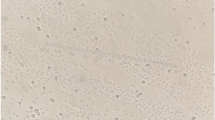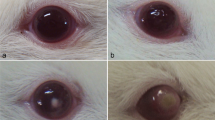Abstract
Acanthamoeba keratitis is a serious sight-threatening disease. The relatively low temperature of the cornea may explain why amoebic infections usually are localized in this tissue and rarely spread to other parts of the eye. In this study, the growth rate of the amoeba Acanthamoeba castellanii was examined at different temperatures. The aim was to establish the optimal growth temperature for A. castellanii and to examine the growth within the vicinity of the core body temperature. The growth rates of four clinical and two environmental strains of A. castellanii were estimated at different temperatures, and temperature limitations for the trophozoite stage was established. Movements influenced by temperature gradients were monitored for two clinical strains of A. castellanii. The highest growth rate for each of the six amoebic strains tested was found to be close to 32 °C. The growth of the trophozoites of all examined strains was greatly reduced or completely halted at temperatures above 36 °C and encysted at the elevated temperature. Thus, the optimal growth temperature for the four strains of A. castellanii is close to the surface temperature of the human cornea, while the higher body core-temperature induced encysting of the amoebae. This may explain why most amoebic eye infections are confined to the cornea.


Similar content being viewed by others
References
Bahat A, Eisenbach M (2006) Sperm thermotaxis. Mol Cell Endocrinol 252(1–2):115–119. doi:10.1016/j.mce.2006.03.027
Clarke DW, Alizadeh H, Niederkorn JY (2005) Failure of Acanthamoeba castellanii to produce intraocular infections. Investig Ophthalmol Vis Sci 46(7):2472–2478
Dart JK, Saw VP, Kilvington S (2009) Acanthamoeba keratitis: diagnosis and treatment update 2009. Am J Ophthalmol 148(4):487–499
Gole L, Riviere C, Hayakawa Y, Rieu JP (2011) A quorum-sensing factor in vegetative Dictyostelium discoideum cells revealed by quantitative migration analysis. PLoS One 6(11):e26901. doi:10.1371/journal.pone.0026901
Hurt M, Neelam S, Niederkorn J, Alizadeh H (2003) Pathogenic Acanthamoeba spp secrete a mannose-induced cytolytic protein that correlates with the ability to cause disease. Infect Immun 71(11):6243–6255
Jensen T, Barnes WG, Meyers D (1970) Axenic cultivation of large populations of Acanthamoeba castellanii (JBM). J Parasitol 56(5):904–906
Khan YA, Kashiwabuchi RT, Martins SA et al (2010) Riboflavin and ultraviolet light a therapy as an adjuvant treatment for medically refractive Acanthamoeba keratitis report of 3 cases. Ophthalmology 118(2):324–331
Khunkitti W, Lloyd D, Furr JR, Russell AD (1998) Acanthamoeba castellanii: growth, encystment, excystment and biocide susceptibility. J Infect 36(1):43–48
Lee GA, Gray TB, Dart JK, Pavesio CE, Ficker LA, Larkin DF, Matheson MM (2002) Acanthamoeba sclerokeratitis: treatment with systemic immunosuppression. Ophthalmology 109(6):1178–1182
Nielsen E, Heegaard S, Hjortdal J (2011) Nye diagnostiske tiltag ved akantamøbekeratitis. Ugeskr Laeger 173(22):1567–1570
Poff KL, Skokut M (1977) Thermotaxis by pseudoplasmodia of Dictyostelium discoideum. Proc Natl Acad Sci U S A 74(5):2007–2010
Preston TM, King CA (1984) Amoeboid locomotion of Acanthamoeba castellanii with special reference to cell-substratum interactions. J Gen Microbiol 130(9):2317–2323
Purslow C, Wolffsohn JS (2005) Ocular surface temperature: a review. Eye Contact Lens 31(3):117–123
Radford CF, Minassian DC, Dart JK (2002) Acanthamoeba keratitis in England and Wales: incidence, outcome, and risk factors. Br J Ophthalmol 86(5):536–542
Rudell JC, Gao J, Sun Y, Chodosh J, Schwab I, Zhao M (2013) Acanthamoeba migration in an electric field. Invest Ophthalmol Vis Sci 54(6):4225–4233. doi:10.1167/iovs.13-11968
Rutherford ST, Bassler BL (2012) Bacterial quorum sensing: its role in virulence and possibilities for its control. Cold Spring Harb Perspect Med 2(11) doi:10.1101/cshperspect.a012427
Schuster FL, Levandowsky M (1996) Chemosensory responses of Acanthamoeba castellanii: visual analysis of random movement and responses to chemical signals. J Eukaryot Microbiol 43(2):150–158
Schuster FL, Mafuzur R, Griffith S (1993) Chemotactic responses of Acanthamoeba castellanii to bacteria, bacterial components, and chemotactic peptide. Trans Am Microsc Soc 112(1):43–61
Acknowledgments
This study was supported by The Danish Council for Independent Research | Medical Sciences, Bagenkop Nielsen’s Myopia Foundation and Machine Manufacturer Jochum Jensen and Wife Mette Marie Jensen born Poulsen’s Memorial Grant. The clinical strains (A2–A5) were kindly provided by Steven Tuft and Massimo Bonaiti (Moorfields Eye Hospital in London, UK). The environmental strains were kindly provided by Sílvia Cervero (Department of Microbiology. Universitat de Barcelona). One strain CCAP 1534/2 (named A10 in this study) was isolated in 1951 in Yale, USA; the other strain (named A12 in this study) was isolated by H. Salvadó and O. Canals from the Department of Animal Biology, Universitat de Barcelona. Experiments comply with the current national laws.
Conflict of interest
The authors declare that they have no conflict of interest.
Author information
Authors and Affiliations
Corresponding author
Electronic supplementary material
Below is the link to the electronic supplementary material.
Supplemental materials Fig 3
An outline of the custom-made brass block for creating a constant temperature gradient on a culture plate. Cold water was pumped through one pipe and hot water through the other. (DOCX 97 kb)
Rights and permissions
About this article
Cite this article
Nielsen, M.K., Nielsen, K., Hjortdal, J. et al. Temperature limitation may explain the containment of the trophozoites in the cornea during Acanthamoeba castellanii keratitis. Parasitol Res 113, 4349–4353 (2014). https://doi.org/10.1007/s00436-014-4109-0
Received:
Accepted:
Published:
Issue Date:
DOI: https://doi.org/10.1007/s00436-014-4109-0




